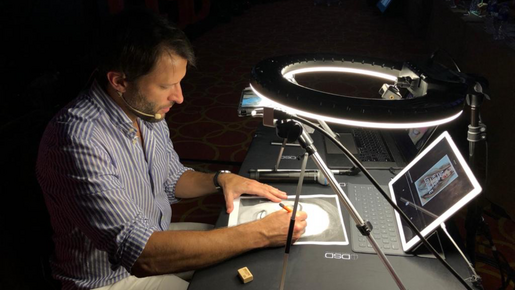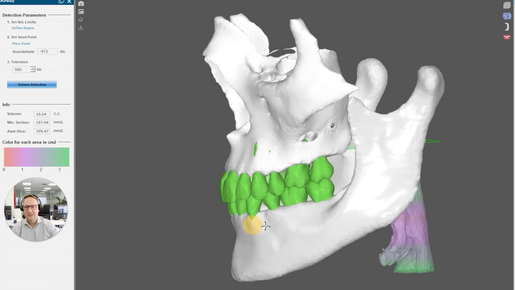Facially driven TADs using the manufactured TAD Guide.

By Daniel Ramos
⋅ 8 min read
⋅ Updated Jul, 2024
With patient demand high, offering modalities that speed up treatment is a sure-fire way to give your clinic a competitive advantage. One such example are TADs, which allow for predictable movement with clear aligners.
With the DSD TAD Guide, placing TADs could not be more straightforward. In this article we will look at what exactly the DSD TAD Guide is, when it might be the right choice for your ortho cases, and how it can help you achieve your desired outcome predictably – and in less time.
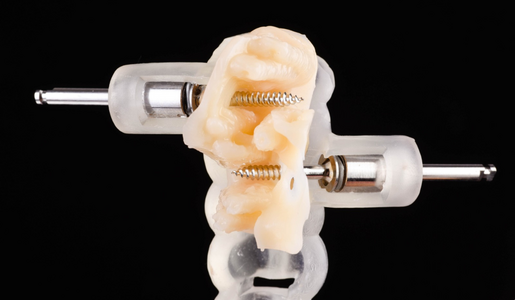
What is the DSD TAD Guide?
With the DSD TAD Guide, we can design the ideal position for mini implants - the skeletal anchorage - for your ortho cases, and also manufacture a guide to use in your patient’s mouth.
Once you have approved the design and the final ideal position for your ortho case, and you know this case requires the use of skeletal anchorage, we use this final ideal position and the initial position of the roots.
Using the CBCT, we segment the roots to understand all the movements they will do and select where to virtually insert the TAD, the mini screw. This needs to be in a position that is far away from the roots and safe, and also that allows us to insert the greatest amount inside the bone. These are the two main factors that can guarantee us a stable procedure and that this mini screw is going to stay in position.
As soon as you have approved the design, you can then either manufacture the guide with our lab or we can export these files to you so you can manufacture it in your own clinic.
What is the intention of the DSD TAD Guide?
To perform less predictable movements with anchors to make them predictable
Controlled and precise fast execution by guiding position and depth
To not affect tooth movements at any time before, during or after TAD placement
Reduced risk of injury during TAD placement
Precise placement to optimize the force direction
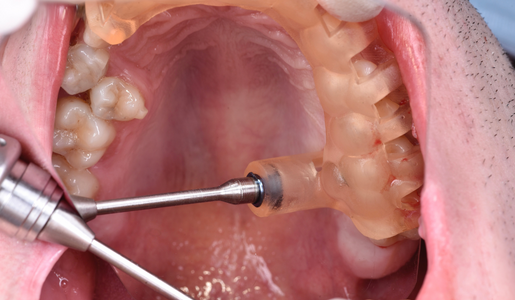
A screw is inserted using the manufactured TAD Guide.
When is the DSD TAD Guide the right choice for my case?
From our experience, from many scientific articles and from discussions with a great number of colleagues, we know that when certain challenging movements are required, we need some help. Aligners alone, or even braces, will not be enough to solve the issue and achieve the final ideal position. This is when we need to use a TAD, a temporary anchorage device, which is another way to refer to skeletal anchorage.
Using a TAD is something that will greatly increase the predictability of achieving the position that we need and that the patient has approved. That’s why it's very important to consider using TADs for your ortho cases when we diagnose these challenging movements. For example, intrusions, big expansions and most of the time big distalizations are some of the movements for which we normally recommend the use of TADs.

To explore how guided dentistry can help you improve predictability while reducing stress, click below:
At what point in the treatment should I purchase the DSD TAD Guide?
The DSD TAD guide is a perfect product to order once the final ideal design has been approved and you know that orthodontic treatment is required and there will be difficult movement.
As soon as you have defined where you want to move the teeth, for example if you are doing a case such as ortho planning that you're going to treat with braces or another system, and you want to use TADs, you can indicate this to us and we will help you to plan the ideal position for the TADs.
However, we are also here to help and we have a specialist team who can help you understand the cases that will require the use of TADs. Often, our team will recommend that you include the TAD guide for a case.
What are the benefits of using the DSD TAD Guide?
Improving the experience for the patient and the doctor
When we launched the DSD TAD Guide, it was used by several highly experienced doctors who have placed hundreds of mini implants freehand. We were happy to hear that despite the fact that they have the experience, knowledge and technique to place TADs without a guide, they felt much more confident and believed that the patient was having a better experience and the procedures were much faster.
Being able to do the procedure virtually first
It's very common to read in the papers that it's normal to lose one TAD in every five, one TAD in every four; there are a lot of statistics about it.
What are the factors that cause us to lose a TAD? The first is when we search too close to a root of the tooth and the second is when we don't insert enough length inside the bone.
To solve this, we do the procedure virtually first. This is part of the DSD TAD Guide - we can understand the whole movement of the root and select a position where we will not contact the root at any point in the treatment.
We can also test drive the ideal length, the ideal size of the TAD, to ensure that the biggest part is inside the bone and very steady and firm. By doing the procedure guided we can eliminate these two factors and greatly increase the success rate for TAD insertion.
There are many reasons why you should use this as a protocol for all your ortho cases in which you want to use TADs, but the most important one in our opinion is that in the end, it is a much safer and better experience for your patient.
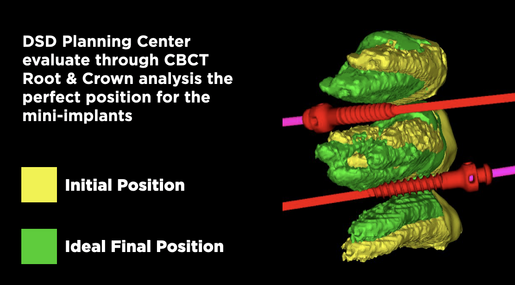
The DSD Planning Center plans the mini-implant position through CBCT root and crown analysis.
How much does the DSD TAD Guide cost?
The cost of the DSD TAD guide will depend on your membership: you can access this by logging in to your account on the DSD website or by checking your billing information.
How do I buy the DSD TAD Guide?
There are two ways to order the DSD TAD Guide:
1. When you receive the indication from the ortho team at the DSD Planning Center
The most common way to order the TAD Guide is when the DSD Planning Center indicates that it is necessary for your case. In this situation, we will recommend it to you and we will leave the product as a suggestion inside the DSD website. You will need to click the product and follow the steps to order it.
2. When you diagnose the need for a skeletal anchorage yourself
The second way is if you receive your presentation with the design, you diagnose the need for a skeletal anchorage and you want to use the TAD Guide. In this case you need to go directly to the website and click the product to order it. It's very easy to do and the product is there on the DSD website for you to order any time you feel the need in your ortho cases.
How do I talk to my patients about the DSD TAD Guide?
It’s true that no patients like to hear that we are going to insert a screw into the bone. They have the worst idea in their minds and imagine it to be a very painful procedure. However, the reality is that it is very simple - it won’t cause any pain and is often even less invasive than prepping a crown for a restoration. It is also something that will completely heal after you remove it.
This procedure isn’t a big deal and we need to get rid of this idea that it is complex. Let's try to explain it to our patients in a lighter way; let’s explain it as a tool we have to reduce treatment time, make it more predictable and help the treatment get to where we really need to: the patient’s approved mock up.
Let's focus on the real benefits: this is a very fast procedure and the patient will be surprised at just how fast and painless it is in reality.
My experience with TADs
“As an orthodontist, I have been placing TADs for several years and when I started, I used to place them freehand without any assistance from technology - evaluating the documentation, X-ray and CBCT but without any simulations. Several issues appeared in front of me and it was considered normal to lose one TAD for every four or five I placed. This was a reality that I never liked.
With time and technology, and then getting to know DSD as an orthodontist before even working here, I saw a great advantage of understanding the final position. And with the integration of the CBCT and the possibility for us to segment roots and bone and have a clear vision of the initial and final position of the roots, we could solve two of the most important factors that can lead to a TAD failure. The first is to place in a position that won't be close to the root at any moment of the orthodontic treatment and the second is to insert the biggest amount of the biggest length of the screw inside a bone.
So the TAD Guide solved these two issues because by simulating virtually first and then creating a guide we significantly reduce these factors that can generate a failure and in that sense, using a guide nowadays to place a TAD is a no-brainer for me. It's a game-changer and I cannot take a step back and place it freehand anymore: I believe that once you know something, once you get to know a new technology and this technology improves our experience and our outcomes, this is something we don't stop using.
The DSD TAD Guide is a technology that will help any dentist or orthodontist to have better outcomes and greater precision when inserting TADs. It makes this procedure very fast, improving the experience for the patient because they are surprised about how fast and painless it is, and it's a huge help for orthodontic biomechanics because it's going to solve one of the most important biomechanic protocols we have: that we need anchorage to move teeth.
For several movements such big distalizations, intrusions, midline corrections, almost all kinds of movements when we surpass a limit where we have good predictability only with aligners, the use of skeletal anchorage with TADs is very helpful to reduce treatment time, to improve the predictability and for us to achieve the outcome as soon as possible.
This is something I use for many cases now in partnership with a lot of clinics all over the world. I can see dentists, colleagues, who have never placed a TAD now placing them with the help of these guides. This is a solution that is suitable not only for the super specialists but also for the dentists who are starting now.”
- Dr Daniel Ramos, DSD Ortho Clinical Mentor
Would you like to learn more about guided procedures?
Now you know more about what the DSD TAD Guide is – and just how much more predictable and safe it makes the procedure of inserting a mini implant in orthodontic treatment, we hope to have encouraged you to use this technique and this guide.
If you are interested in more procedures that can be faster, more predictable and less stressful for you, while providing your patients with a better experience, we recommend exploring our Guided Dentistry certification.

